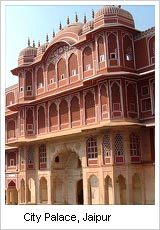Introduction:
The Jantar-Mantar (Sanskrit; translated as
“Magical Device”) was built between 1728 and 1734 due to the
drafts of Maharaja Jai Singh II (1693 -1743) in the centre
of Jaipur, which itself was founded 1727 as new capital city
of his principality. One of the major tourist attractions
in the Pink city of Jaipur is the sun dial of Jantar Mantar.
The Jantar Mantar at Jaipur was conceived as a quest for discovering
the mysteries of the Cosmos.
The Jantar Mantar is a corruption of the Sanskrit word yantra
mantra meaning instruments and formulae. It was built not
only to verify astronomical observations made at Jaipur, but
also to stimulate interest in astronomy, which had become
enmeshed in theory, superstition and religious jargon. Raja
Jai Singh had a deep interest in astronomy. He read all the
known works on the subject at the time (c1800's). He also
collected the most advanced instruments he could find. During
his studies, he noted inaccuracies in existing astronomical
tables and decided to produce his own astronomical instruments.
Because he felt that the instruments' size limited their accuracy
(they were too small), his solution was to build gigantic
instruments from stone, masonry, and marble rather than the
traditional brass. The observatory consists of fourteen major
geometric devices for measuring time, predicting eclipses,
tracking stars in their orbits, ascertaining the declinations
of planets, and determining the celestial altitudes and related
ephemerides. Each is a fixed and 'focused' tool.
The Samrat Jantar, the largest instrument, is 90 feet high,
its shadow carefully plotted to tell the time of day. Its
face is angled at 27 degrees, the latitude of Jaipur. The
Hindu chhatri (small domed cupola) on top is used as a platform
for announcing eclipses and the arrival of monsoons. You can
visit this very Jantar Mantar (Observatory) in Jaipur, Rajasthan
and see with your own eyes the wonderful masonry instruments.
The observatory has the Jaiprakash Yantra, Samrat Yantra,
Ram Yantra and the Composite instrument, which comprises of
a sundial and a massive hemisphere.
Jantar Mantar presents the observatories through a variety
of media and information sources, making it possible to explore
and learn about these historic sites through interactive panoramic
"VR" photographs, time lapse sequences, and 3D models
as well as articles, drawings, and historic texts. Jantar
Mantar has a remarkable collection of architectural astronomical
instruments. It portrays noteworthy attempt of the ancestors,
who were interested in astronomy and knowledge of celestial
bodies. Above all, this observatory still, provides accurate
information, which can be compared with today's modern instruments
undeniably. The compound instruments, whose settings and shapes
are scientifically designed depicts the forte of Medieval
Indian Astronomy.
|
|
 |

